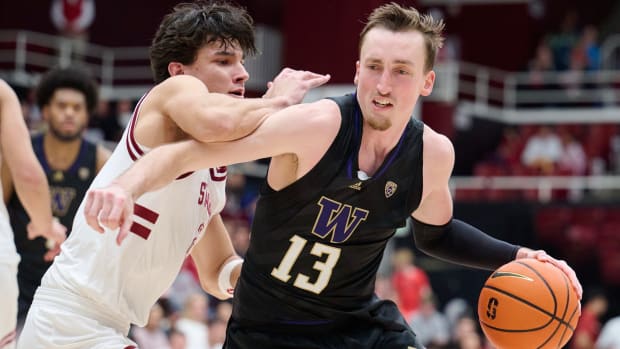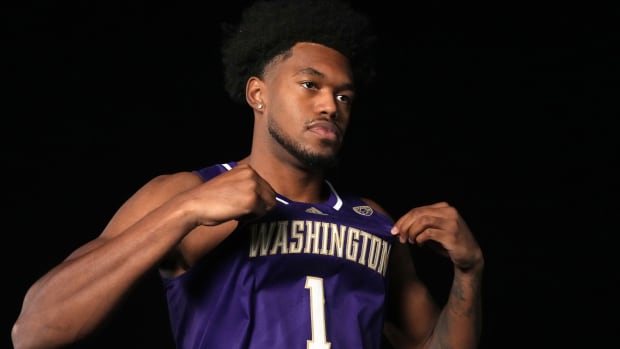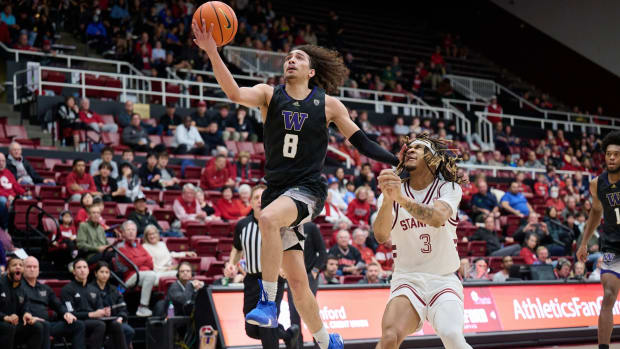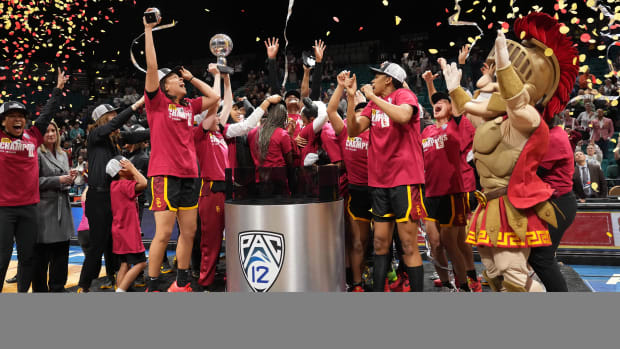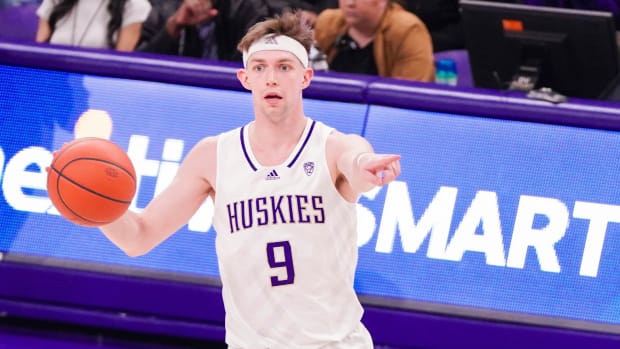Grading Hopkins' 5 UW Basketball Recruiting Classes
Mike Hopkins took over the University of Washington basketball program in 2017 after long-time coach Lorenzo Romar was let go and every Husky recruit lined up but one bailed on him.
Welcome to Seattle.
Hopkins, a former Syracuse assistant coach for Jim Boeheim, saved face that first year by signing a Romar commit in guard Jaylen Nowell, found another local player with capable offensive skills and brought a pair of New York recruits with him.
Two years later, the Husky coach seemed like he could do no wrong when Hopkins landed a pair of 5-star recruits, 6-foot-9 forwards Isaiah Stewart and Jaden McDaniels, which clearly was a first for the program.
Yet Hopkins appears to have whiffed more than he's hit home rums in acquiring Husky basketball talent. Or he's not signed anybody on the high school level at all, choosing to hand out scholarships to transfers.
With his Washington team off to the worst start (1-7) in program history in 63 seasons, we break down his five recruiting classes and grade them:
2017
Hopkins awarded scholarships to forward Hameir Wright, forward Nahziah Carter, guard Michael Carter III and Nowell. Only Wright remains with the program to the end.
Nowell gave Hopkins two strong seasons, averaged 16.2 points per game as a sophomore, was named 2019 Pac-12 Player of the Year and headed for the NBA. Watching his sluggish pro basketball progress, the backcourt player from Seattle's Garfield High School could have used another college season.
Naz Carter started one of his three seasons with the Huskies, averaging 12.2 ppg as a junior. While he was one of the more entertaining dunkers to come through Alaska Airlines Arena, he didn't or wouldn't accept a leadership role when the team needed him most last season. Worse, he recently was banished from the team and school amid sexual assault allegations.
A 6-5 guard, Michael Carter played half a season for the Huskies and transferred out to South Dakota State, where he didn't stick around long enough to play. He's in his second season as a starter for Long Beach State, a junior averaging 14.3 ppg this season after scoring 12.4 a game last season.
That leaves Wright, a 6-9 role player. He's started 60 of 100 games, but would be better suited as a reserve. He has minimal offensive capability. He averages 5 points per game, 3.5 over his career, and shoots just 15.8 percent from 3-point range. Opposing teams sag and encourage him to launch it.
Hopkins found an NBA player and three scorers overall, but none of them hung around long.
Grade: B
2018
This is where Hopkins really fell down in his talent assessment. He signed four players in Nate Roberts, Jamal Bey, Elijah Hardy and Bryan Penn-Johnson. All four showed up with limited skills.
Only the 6-11, 265-pound Roberts has been semi-productive or a full-time starter. The sophomore averages 6.3 points and 7.5 rebounds. However, the Huskies would be better served if they could use him in support of another more offensive-minded big man and just let Nate do the dirty work.
Bey is a program conundrum. He's got good size as a 6-6 junior guard, but he doesn't put the ball in the basket much. In 65 career games, he averages just 3.3 ppg and continues to shuttle in and out of the starting lineup.
Hardy was outmatched at the Pac-12 level. He appeared in 36 games over two seasons, averaged just 1.1 points and 0.7 assists, started just once and transferred to Portland State. With his new WCC team, Hardy has played in just four of six games and started one, averaging 4.5 points and 2.0 assists an outing.
That leaves 7-footer Penn-Johnson. He played in 11 games and scored 12 points over two seasons and gave up on the Huskies. He transferred to LSU. Things haven't gone any better for him in the South, where he's still drawing limited minutes. He recently went home to California and it's not clear if he's coming back.
Hopkins hurt himself with this group.
Grade: D
2019
The trumpets blared loudly when Hopkins held up the national letters of intent signed by Stewart and McDaniels. He beat out Kentucky for both of them, unheard of by any program. All along, it was clear they would be one-and-done players. He also brought in guards RaeQuan Battle and Marcus Tsohonis.
Stewart was everything as advertised, starting 32 games last season and averaging a team-best 17 points and 8.8 rebounds per game. He continuously played harder than any UW player since Detlef Schrempf 35 years earlier. He was the 16th player drafted who ended up with the Detroit Pistons.
McDaniels was a program disappointment. Extremely gifted physically, he was an immature player, drawing six technicals, babying an injury and losing his starting job for 10 games to end his career. He averaged 13 points and 5.8 rebounds an outing. The Huskies needed him to step up and be a leader for a fragile team, not be in need of a babysitter. He was the 28th player drafted who ended up with the Minnesota Timberwolves.
Battle is a 6-5 sophomore who is ultra confident and offensive-minded. He has more skills than most players on the roster. He doesn't always take good shots, but he can score, putting up 19 points against Oregon. Hopkins should make him a full-time starter.
Tsohonis is a somewhat unconventional player who doesn't always get into games, but he's more productive than some of the other guys. Last season, the true freshman started six games and averaged 7.1 points and 2.1 assists per game when he was supposed to redshirt. Largely ignored this season, he still scored 14 points in 12 minutes against Colorado.
Hopkins bet everything on a pair of one-and-done players and the program results were negligible, with a losing season (15-17) resulting.
Grade: B+
2020
Hopkins chose to give scholarships to transfers and he brought in junior-college point guard Nate Pryor, Wichita State shooting guard Erik Stevenson and Michigan swingman Cole Bajema, all of these arrivals coming a year after picking up USC forward J'Raan Brooks and two years after securing Kentucky guard Quade Green.
A total lack of high school recruits for an entire cycle is an extremely risky proposition when trying to rebuild a program.
Grade: F
2021
Washington state was full of 4- and 5-star recruits and Hopkins landed just one of them, Olympia's 6-9, 200-pound Jackson Grant, who's considered a top 100 player. Grant will need to bulk up a great deal before he's able to contribute much at the Pac-12 level. That's it for recruits, local or otherwise. The other guys who emerged with reputations statewide signed with Kentucky, Duke, Gonzaga and Arizona, the latter securing Nowell's younger brother, Shane.
Grade: C
Overall
Two of Hopkins' five classes graded well, both producing NBA players. Three rate poorly. We're going to put the coach on academic probation until we see improvement. As the losses pile up, the school might feel the need to take stronger measures.
Grade: C-
Follow Dan Raley of Husky Maven on Twitter: @DanRaley1 and @HuskyMaven
Find Husky Maven on Facebook by searching: HuskyMaven/Sports Illustrated
Click the "follow" button in the top right corner to join the conversation on Husky Maven. Access and comment on featured stories and start your own conversations and post external links on our community page.
